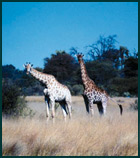
Yet Tanzania’s conservation system, a legacy of the colonial period’s centralized command-and-control, does not provide incentives for rural landowners to protect wildlife on their land. Partly due to this lack of incentives, wildlife outside of parks is declining in some critical habitats. Recent estimates place the ungulate population of Tarangire National Park at approximately 60 percent of what it was a decade ago.1 Such declines represent a serious threat to Tanzania’s wildlife resource, which makes significant contributions to national income and government revenue through tourism, as well as providing food for much of the rural population.
Besides overreliance on protected areas, Tanzania’s conservation efforts lack collaboration between government sectors, and, most importantly, do not engage rural communities to help protect animals as they move from place to place. Wildlife is more of a burden to rural people in Tanzania than the bounty it can potentially be. Wild animals often destroy crops and make daily chores such as fetching water and firewood risky.
Wildlife outside of national parks falls under the jurisdiction of the 1974 Wildlife Conservation Act, which vests the power to control this wildlife in the hands of the Director of Wildlife. The director holds all the cards when it comes to utilizing wildlife in Tanzania. The director approves hunting blocks (areas of land leased for tourist hunting), issues regulations for wildlife management, and must approve any type of wildlife utilization outside national parks, including photographic tourism.
Currently, the central government captures the vast majority of benefits from wildlife and invests little of that into either village welfare or conservation. Village lands often overlap with hunting blocks, but communities are given no control over hunting on their land and receive paltry benefits. Only 25 percent of hunting fees are retained by the district government; the rest goes to the central treasury. Of the 25 percent retained by the district, very little reaches individual communities, which are often in dire need of basic services, such as schools, potable water, and basic medicines.
None of the three primary ways in which wildlife is used�? photographic tourism, tourist hunting, and resident hunting�? provides significant benefits to communities when conducted under government approval. Even hunting under the resident hunting system is prohibitively expensive to the average rural villager because it requires costly modern weapons. Thus many villagers are effectively barred from legally using wildlife as a source of protein.
Such centralized control contradicts Tanzania’s Wildlife Policy, issued in 1998, which advocates devolution of control over wildlife resources outside protected areas. The avowed goal is to engage communities in conservation and to empower them by giving them user rights to wildlife and management opportunities and responsibilities.
Despite this impasse, some important opportunities are emerging for communities to benefit from wildlife through tourism. Some villages have entered into contracts with safari companies and are earning from $5,000 to more than $50,000 annually.
Ololosokwan village in Ngorongoro District earned $55,000 in the 2002Ð2003 tourist season from photographic tourism ventures on village land, marking a new high in earnings over the past few years. This village borders Serengeti National Park and Kenya’s Maasai Mara, and thus is a critical dispersal area for wildlife, as well as part of the yearly wildebeest migration route. Although the companies operating in this area do not have government approval for their activities, they are making significant financial and infrastructure contributions to the village (such as financing a clinic). In turn, the village has dedicated a large portion of its land to shared use by wildlife and cattle. The village also helps support four village game scouts, who monitor the use of this area.
Ololosokwan provides an example of community-based wildlife management generating win-win situations. The villages clearly benefit from the financial and infrastructure inputs, but they also benefit by securing areas that can be used for grazing and conservation, and they increase their knowledge through interactions with outfitting companies and non-governmental organizations. The companies gain exquisite wildlife viewing and wilderness camping in a unique area. The government gains the protection of a national resource, as well as a share of revenues from increased tourism. And lastly, the wildlife gains protected habitat.
The success of Ololosokwan reflects its wealth of resources, astute village government, and firm knowledge of villagers’ land rights. Not every village in Tanzania has similar resources, skills, or knowledge. Before these methods can truly be put to the test across Tanzania, communities must be given user rights to wildlife, have clear title to their land, and develop their management capacity. At that point, rural communities can start using these resources without fear that gains will be commandeered by the central government.
The longer it takes government to create institutions that generate true community-level incentives, the more loss of habitat and wildlife Tanzania will incur. In the meantime, besides losing the valuable wildlife resource, many rural Tanzanians are missing out on the opportunity to capitalize on their resources, thus losing not only potential earnings, but the social and financial capital that could be created for tomorrow.
NOTE
1. Personal conversation with Charles Foley, head of the Tarangire Elephant Research Project, April 14, 2004, in Arusha, Tanzania.
Elizabeth Singleton is a policy officer with the Sand County Foundation Community Based Conservation Network, Arusha, Tanzania. In 2001, she was a fellow at the Kinship Conservation Institute conducted annually by PERC.



